“And a most curious country it was. There were a number of tiny little brooks running straight across it from side to side, and the ground between was divided up into squares by a number of little green hedges, that reached from brook to brook. “I declare it’s marked out just like a large chess-board!” Alice said at last. “There ought to be some men moving about somewhere – and so there are!” she added in a tone of delight, and her heart began to beat quick with excitement as she went on. “It’s a great huge game of chess that’s being played – all over the world.” “
(Lewis Carroll – Through the Looking Glass)
For the past three years, every October I have travelled on the Chess Train, the unique chess tournament organised by the Prague Chess Society. In the absence of any travel this month, I look back to my second such trip, in 2018, which visited the Czech Republic and Poland.
Wednesday 10 October 2018 – London to Prague
The journey to Prague was now familiar, as it it was the third time that I had made it in just over a year. I had chosen the same hotel to stay in as I had on my previous visit for the Chess Train the year before. Once I had arrived, I researched somewhere to eat that evening and chose a bar/restaurant that I had not been to before about a mile from my hotel in the Vyšehrad area of the city.
My research had been effective and the place I had chosen to eat was excellent – I ordered pork with plums. Shortly after my food was served, a man arrived with a vicious looking dog and sat at the next table to me. While the man was preoccupied on his mobile phone, the dog spotted my plate of food and moved closer to me. The dog was growling while it kept a steady eye on my dinner and I feared that it might not be my dinner for much longer. However, I was saved when an elderly lady arrived with a tiny dog and sat at a table on the other side of me from the vicious dog. The vicious dog thought that the tiny dog would make a better dinner than my plate of food and had to be restrained from attacking the tiny dog. But then a couple with a small child arrived in the bar. While they went to a table on the far side, the child, who was no more than a toddler, spotted the dogs and came running over. I had real fears for the safety of the child, but as soon as she arrived the vicious dog rolled onto its back to have its tummy tickled. So the vicious dog was a softy after all and peace was restored for the rest of the evening.
Thursday 11 October 2018 – Prague
As in the previous year, I had a spare day in Prague before the departure of the Chess Train and I used it to go to places that I had not visited before.
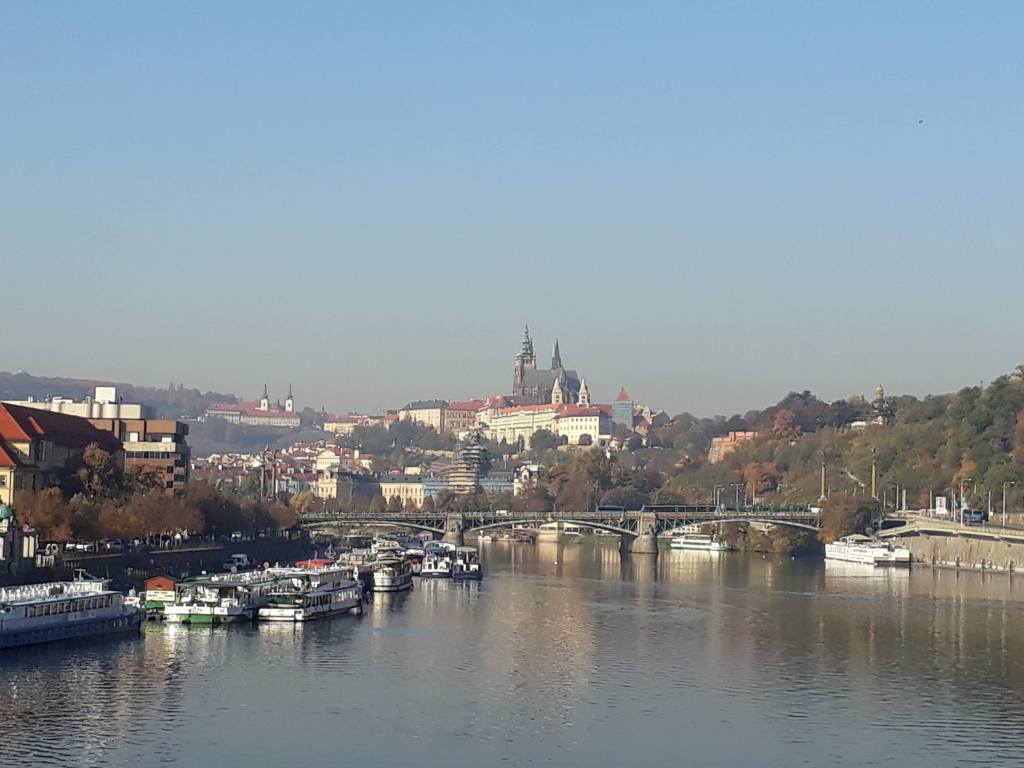
First stop was the National Technical Museum – this is an extensive museum of science and technology, situated on a hill on the north bank of the Vlatava river. It took me all morning to look at the exhibitions. There were a couple of things that I had not previously known which I found particularly interesting. The first soft contact lenses were developed in Czechoslovakia in the 1950s, much to the consternation of Western observers who did not think that communist regimes were capable of such technological breakthroughs. Apparently, one of the Czech pioneers of the soft lens would demonstrate its effectiveness by removing one from his eye, then stamping on it, before wiping it clean and reinserting it. The museum helpfully suggested that it is not recommended that you try this. I also discovered by looking at the historic cars in the museum that Czechoslovakia drove on the left prior to the German invasion in 1939. Although a switch to right hand driving had been planned, the Nazi occupation of the country caused the change to happen immediately and it was never reversed.
After leaving the National Technical Museum I walked through the park on the ridge of the hill and cut across the Prague Castle complex. Walking down from the castle and onto the Charles Bridge the streets were packed with tourists. I sought sanctuary in the Bedřich Smetana Museum, a haven of tranquillity at one end of the Charles Bridge. The museum is devoted to presenting the life and works of the 19th Century Czech nationalist composer, Bedřich Smetana, whose grave I had visited on my final day in Prague the previous year. The museum is not large, but is well worth spending an hour looking round. Digressing slightly, Vyšehrad from Smetana’s Má vlast was used as basis of the jingle which preceded announcements at Prague’s main railway station. In fact many stations in the Czech Republic (and in Slovakia) had their own unique tune. Sadly, I have learnt that, as of this summer, in an act of modernisation, they are no more. To hear what has been lost, I found this compilation of a selection of the station tunes.
My final visit of the day was to u(p)m (The Museum of Decorative Arts in Prague). I think my guidebook may have misled me about what to expect, as there were no permanent displays, but just three special exhibitions. At the time of my visit the three exhibitions were devoted to Hana Podolská (a Czech dressmaker of the inter-war period), Krásná jizba (a school of functionalist interior design which operated between 1927 and 1948), and a display of experimental modern ceramics. None of these were really my cup of tea, so I left feeling slightly disappointed.
In the evening, I returned to a bar that I had visited in previous years and chose duck to eat.
Friday 12 October 2018 – Prague to Ostrava
I got up early and made my way to the main railway station, Praha hlavní nádraží, to arrive at 8am. After registering and taking my luggage to the platform from which the Chess Train was due to depart, I went inside the the Government Lounge. There was, as usual, a generous buffet breakfast being served. It was good to see so many familiar faces from the previous year; in addition, there were this year a couple of other players from the London area, who I knew slightly from the local leagues I play in.
At 9am we were all gathered together for the opening ceremony, followed by a final briefing for this year’s tournament. I was slightly disappointed to learn that, compared to the previous year, the time control for the games was being tightened with only 5 seconds increment per move rather than10 seconds (in addition to the 20 minutes each player starts with on their clock). As someone who never seems to have enough time when playing, I thought this would not help me, but, as I would soon discover, it turned out to be to my advantage.
Once the formalities had concluded all the participants went to the platform from which the train was due to depart. Once there, I noticed that the specially decorated Šachový Vlak locomotive could be seen in sidings on the far side of the station. For some reason it would not be pulling the Chess Train this year.
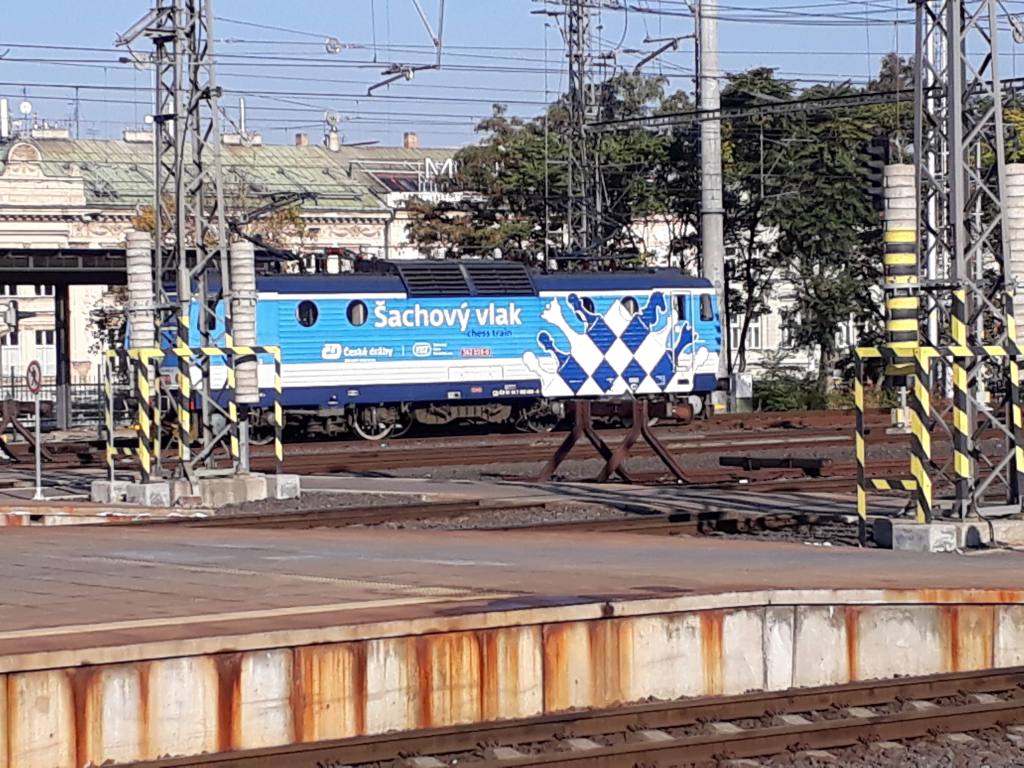
The next surprise was that the Chess Train then rolled into to the platform adjacent to the one where all the participants were waiting. We all had to retrieve our luggage from where it had been placed to be loaded onto the train and carry it via the subway to the next platform.
Once on board the train, I found the compartment where I was to play my first round game. I was playing an Italian, whose rating was much higher than mine. His non-playing companion also sat in the compartment watching the game, which I found a little disconcerting. I made a complete mess of my opening and was losing from an early stage of the game. Rather than resign immediately, I played on. While not recovering my material disadvantage, I started to make my opponent think. Unfortunately for him, he thought too long and inadvertently let his clock run out. Much to his consternation he had lost on time. So the smaller time increment this year did benefit me after all. My reward for an unexpected first round win, was to play an even stronger Dutchman in the second round. I had no such luck this time and was well beaten.
We arrived in Ostrava in the early afternoon. The station is a little way from the city centre, where my hotel was located. Rather than getting a taxi, like many of the Chess Train players did, I bought a tram ticket from a machine outside the station and caught a tram to the centre. After checking into my hotel, I set out to explore the city. Until recently, Ostrava had been a major industrial city, based on coal mining and steel production – and now is reinventing itself for a post-industrial future. There is a large science and technology centre in one of the old steelworks, which unfortunately I did not have time to visit. Instead I went to the Ostrava City Museum, housed in the old City Hall building situated on the main central square. The museum provided a potted history of the city, as well as an exhibition explaining the geology of the area on which the city’s mineral wealth was based. It also had an exhibit about the 1923 chess tournament in the city, won by Emmanuel Lasker, and featuring many of the great names from a golden age of chess.
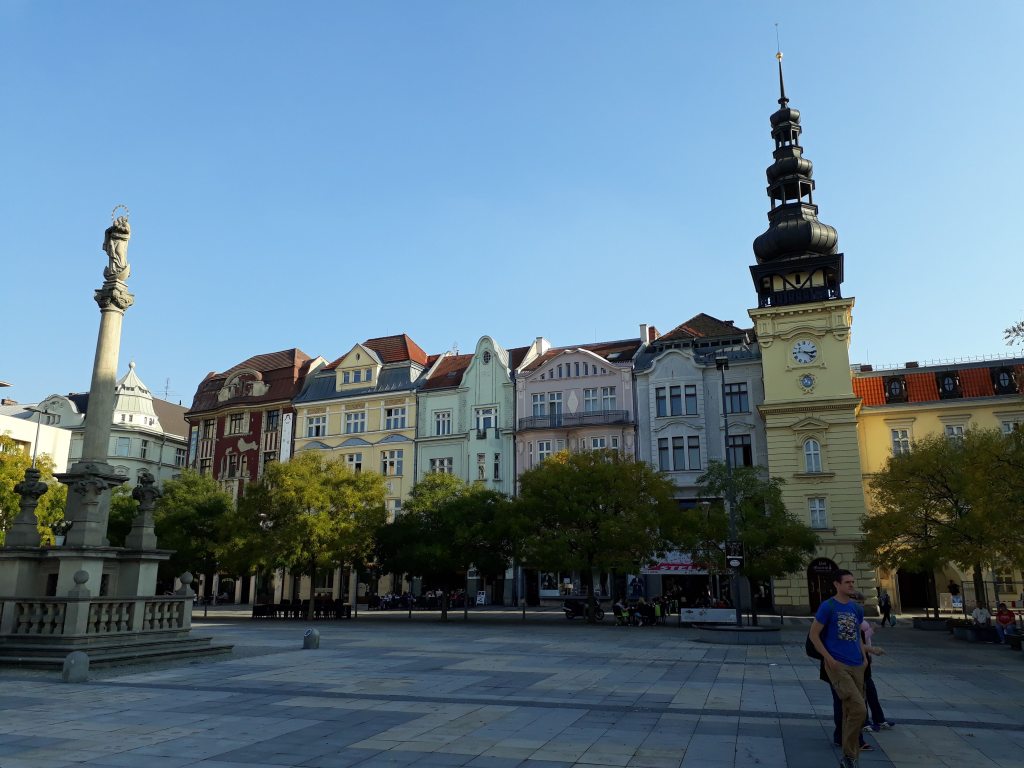
After I left the museum I wandered around the old centre of Ostrava, which had great charm and not what I was expecting from a city famous for its industrial past. I also kept an eye on suitable places to eat later that evening.
I chose to eat in a pub near the centre. When I arrived, all the unoccupied tables had reservations, so the barman could only offer me a place sitting at the bar. I ordered goulash with dumplings to eat. Shortly after my food was served, the two Chess Train participants from London that I knew slightly arrived in the bar and were lucky that a table was just being vacated. They invited me to join them at their table and we spent the evening discussing our trip so far.
Saturday 13 October – Ostrava to Warsaw
There were three games played on this day. The less said about my performance the better – I lost to two German men (one a Chess Train regular) and and Australian woman (the wife of the eventual winner of the tournament).
Shortly after the final game finished we arrived in Warsaw, ahead of schedule. My only previous visit to Warsaw had been in 1992 – it was shortly after the collapse of communism, when the country’s economy was ravaged by inflation. Earlier in 2018, I had been to Hull to play in the British Chess Championships. Hull in 2018 reminded me a lot of Warsaw in 1992 – a few cultural hotspots situated in a bleak urban landscape populated by drunks and beggars. By 2018, Warsaw had been transformed. My hotel was near Warsaw Centralna station, where the train had arrived. I remembered Centralna from 1992 as a fairly gloomy drab place, but it had been revamped and was now a bright modern station. To get to my hotel, I just had to walk through the rather upmarket shopping centre adjacent to the station.
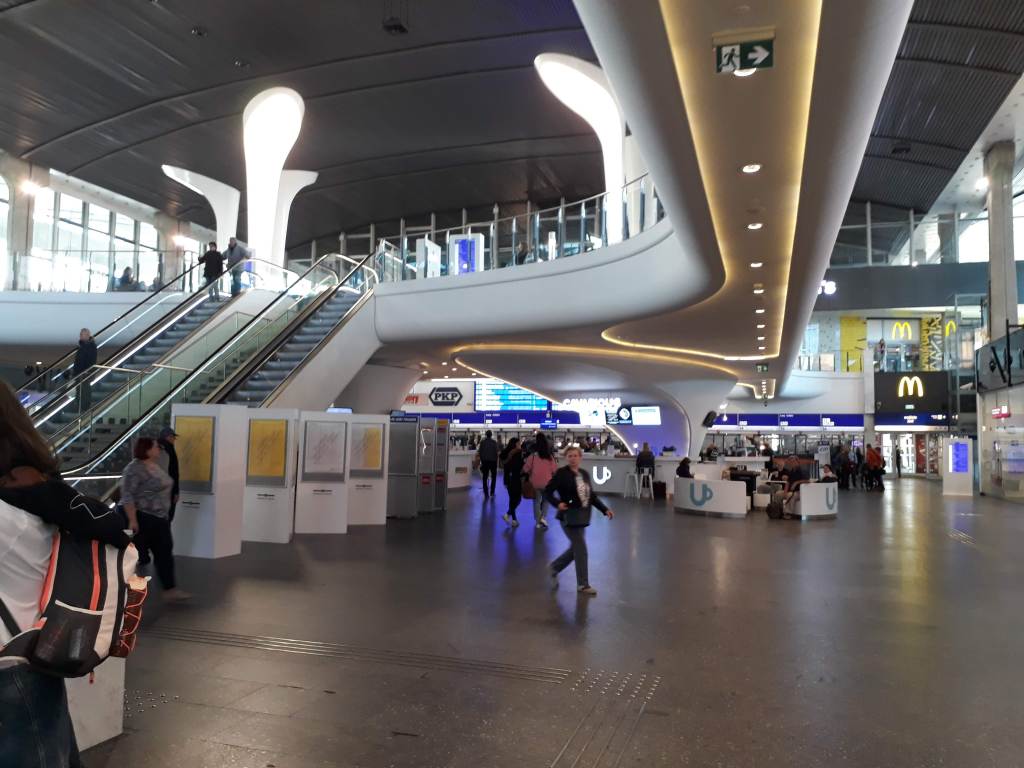
After dropping my bags at the hotel, I immediately set off again to walk through Warsaw, bathed in warm afternoon sunshine. There were lots of people about – the cafes and restaurants all seemed to be busy, some with people waiting outside to get in. My destination was the Old Town Market Square to visit the Museum of Warsaw. The museum is located in eleven town houses which have been amalgamated at the north end of the square. I think I visited the museum on my previous visit to the city in 1992, but the exhibitions had been modernised and extended since then. The history of Warsaw, from its founding to the present day, is told in the twenty one rooms of the museum. It was a fascinating place and I only just finished looking round it by its closing time at 6pm.
I walked from the Old Town Market Square to the main square in front of the Royal Palace. A band was about to start performing and the space was packed with people. I continued walking through the city to where I had chosen to dine that evening – a Georgian restaurant a few blocks south of the Palace of Culture.
When I arrived at the restaurant, I discovered that it was located in the basement of a building. I had to wait a little while for a table to become available. I had spicy meat kebabs washed down with a couple of different Georgian beers. When dining alone, one cannot but help notice the other diners around you. There was a large group celebrating a young man’s 25th birthday – the birthday boy and his family were all very smartly dressed, while his friends clearly did not receive the message about the dress code and were somewhat scruffier. More intriguing were two men who came and sat at the next table to me a short while after I arrived. They rather brusquely ordered a bowl of soup with dumplings each. One of the men then produced in succession a number of large wads of money of different currencies, which he proceeded to split with his companion. Once the companion had pocketed his share of the money, he immediately left the restaurant leaving his food unfinished. One can only speculate on the origin of the money and what they were doing.

Sunday 14 October – Warsaw to Krakow
Despite Polish Sunday trading regulations preventing any of the shops in the shopping centre adjacent to my hotel being open, the shopping centre itself was still open, providing a convenient short cut to Warsaw Centralna station, where the Chess Train departed at 10am.
I beat an Englishman in my first game and in the second lost to a Swiss man against whom I had drawn the previous year. We arrived in Krakow in the early afternoon.
I was initially slightly disoriented when leaving Krakow station and came out on the wrong side to the one I needed to catch a bus to my hotel. My mistake was soon rectified and I travelled to my hotel which was a fifteen minute bus ride to the west of the city. As is my usual practice, I just dumped my bags and set out again to explore. I had also visited Krakow in 1992, when I recall the city centre being virtually deserted in the evening. Of course it had changed enormously and the centre was bustling when I arrived.
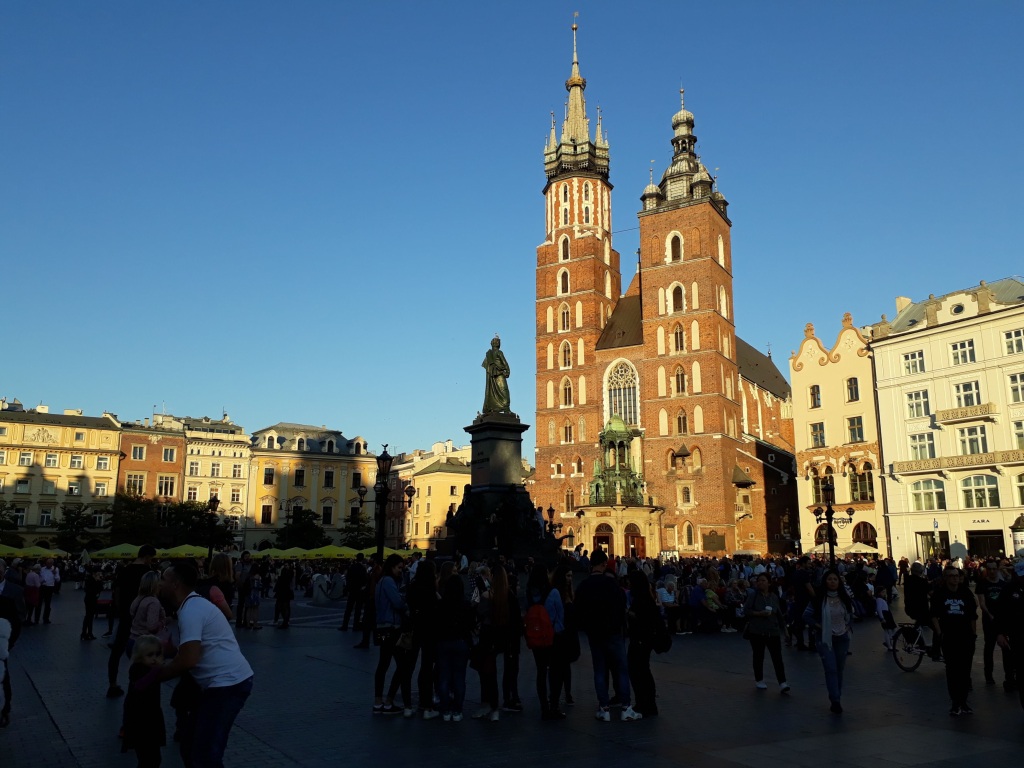
I made my way to the heart of the city, the main square (Rynek Glowny). The square was excavated between 2005 and 2010 to uncover archaeological remains dating back to at least the 11th Century. The results of these excavations can be seen in a subterranean exhibition located underneath the square, Rynek Underground. This is an amazingly extensive space showing, in situ, the ancient foundations of the buildings of the square together with numerous artefacts and multi-media presentations of the history of Krakow. By the time I had finished in Rynek Underground it was now evening and most of the other potential attractions had shut. I then walked to the south of the old town to visit the Wawel castle. Although it was too late to go into any of the Wawel’s buildings, the courtyards were still accessible and one could wander about admiring the views over the Vistula river below.
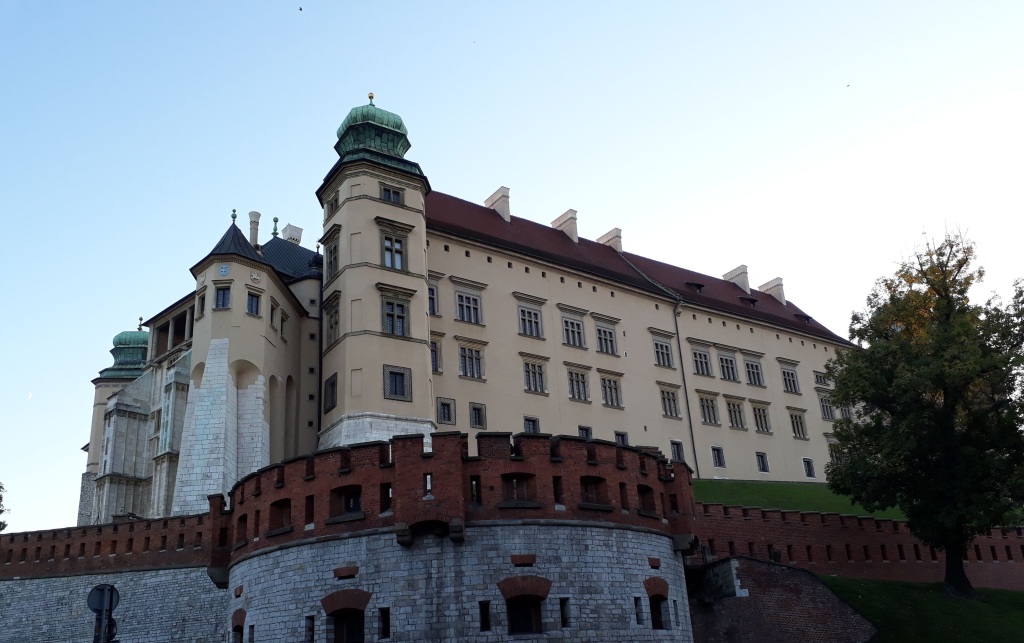
Poland still retains its own currency, the Zloty. I was not sure how much cash to bring with me for my two days in Poland. Prices of entry to attractions and for eating out had been low, so by the evening in Krakow I had only spent about a quarter of my Zloty cash. Consequently, for my final evening in the country I could afford to dine out more extravagantly than usual. I found a nice restaurant, where I had a three course meal: beetroot soup with meat dumplings, chicken stuffed with cheese sauce, and cheesecake with hot chocolate sauce, together with a selection of interesting Polish wheat beers to drink. The meal was very reasonably priced and I still had over half of my original cash unused.
Feeling rather full, I walked slowly to the bus stop to catch a bus back to my hotel. I discovered that on a Sunday evening the frequency of buses in Krakow reduces significantly. Additionally, my hotel was near student accommodation for the university, so there were a lot students who were returning after a weekend away wanting to catch the bus. Consequently, the bus was packed and I only just managed to squeeze on.
Monday 15 October – Krakow to Hradec Králové
After breakfast in my hotel, I caught a bus to Krakow Glowny station. Monday morning rush hour traffic in Krakow meant that the journey took rather longer than I expected. I was not concerned about missing the the train, as I had allowed plenty of time, but I did manage to exceed the twenty minute validity of the bus ticket that I had bought. At the shopping centre by the station, I made one last attempt to spend my remaining Polish currency, but found nothing that I wished to buy other than a few snacks in a supermarket.
Not long after leaving Krakow the train left the main line and after passing through Oświęcim the track conditions became poorer, resulting in the Chess Train travelling very slowly over the next few miles. The line between Oświęcim and Czechowice-Dziedzice normally has a very infrequent passenger service and judging by the puzzled looks of the locals as we passed slowly through, I think they were surprised to see the 14 carriages of the Chess Train on their line.
This day was to be the longest on the train. Three games were played – against a Swiss and two Czechs (the second of whom was a young boy, the youngest player in the tournament). I managed to win one, draw one and lose one. I did not feel that I was playing well and was making too many unforced errors. I had had a cold in the week before departing, and although I thought it had cleared up I was feeling tired by the fourth day on the train.
As we were not due to arrive in Hradec Králové until the early evening, the Chess Train had organised a problem solving competition for the afternoon. I had entered this, being pleased that I had solved the qualifying puzzle the day before. However, I decided that I was too tired to enjoy the competition, so instead took the afternoon off and retired to the restaurant car to enjoy a beer and admire the views.
After going through Pardubice, the train headed north to Hradec Králové. When it arrived, the train was slightly too long for the platform at Hradec Králové, so the luggage car did not quite fit. A human chain was formed to help unload the bags onto the platform.
When I left the station it was just starting to get dark. There did not appear to be any useful public transport due to depart, so I decided to walk to my hotel. Navigating using my phone, I initially missed a turning down some steps, so it took slightly longer to get to the hotel than I had anticipated. When I got there, there was a long queue of Chess Train participants waiting to check-in. I eventually was given a key for my room. The hotel was a sprawling complex spread over several buildings and my room was probably as far from the reception desk as possible. Unfortunately, the key I had been given did not work and I had to trek all the way back to get it replaced. When I did gain access the room was enormous. I did not linger there, but decided to head straight out to find something to eat. I chose a typical pub just off the main square, where I ordered a steak to eat. Shortly after I arrived, the boyfriend of the barmaid also arrived and she seemed more interested in talking to him than serving her customers.
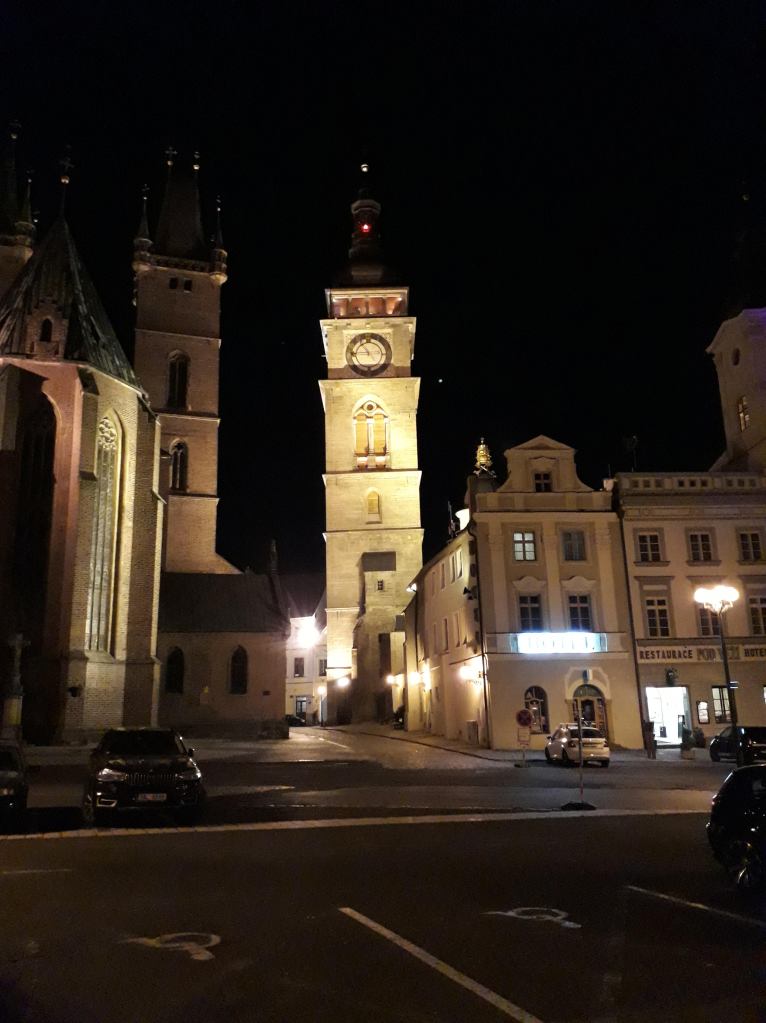
After dinner I had a short stroll around the centre of Hradec Králové, which was very atmospheric in the dark.
Tuesday 16 October – Hradec Králové to Prague
I got up fairly early so that I might explore Hradec Králové in daylight before the Chess Train departed. The city has a very elegant market square – it is a shame that much of it is now used as a car park. I contemplated going to the top of the White Tower at one end of the market square, but concluded that it would be too much of a rush to appreciate it properly.
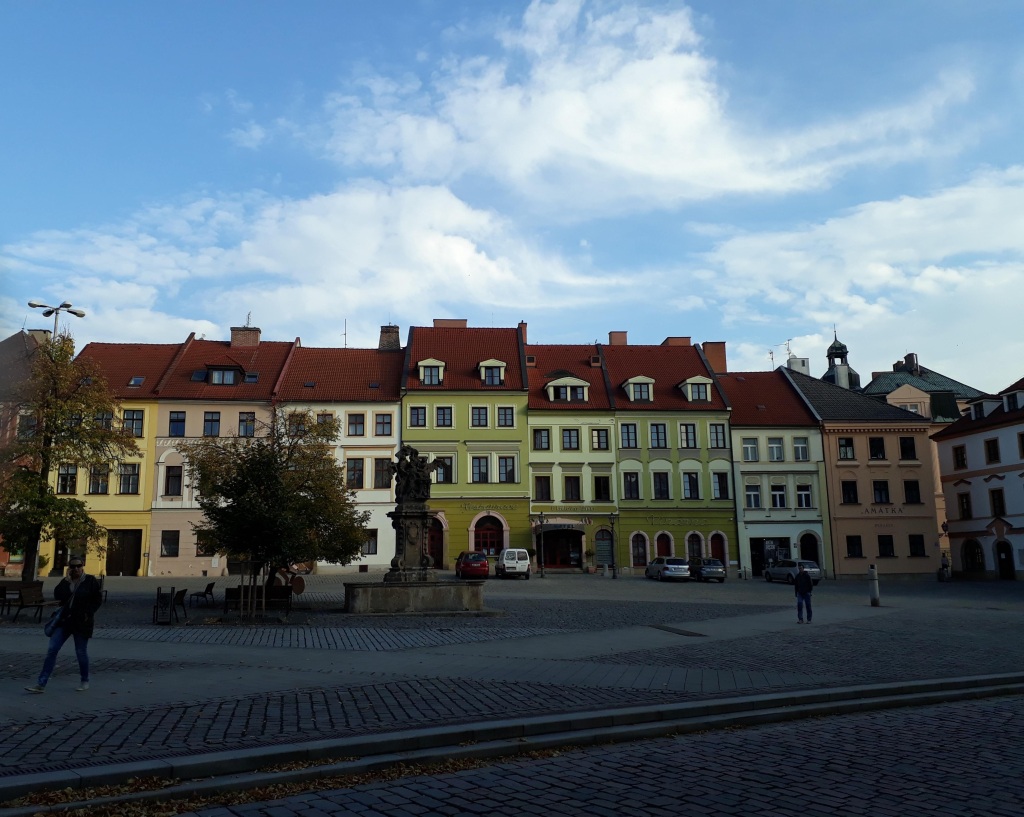
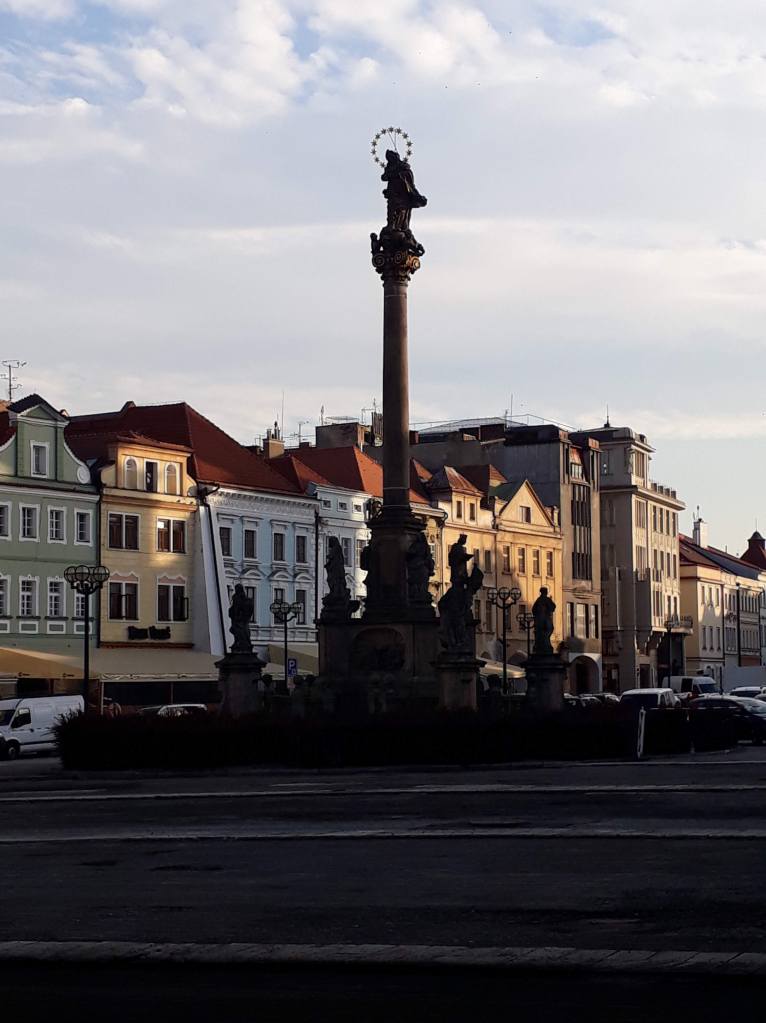
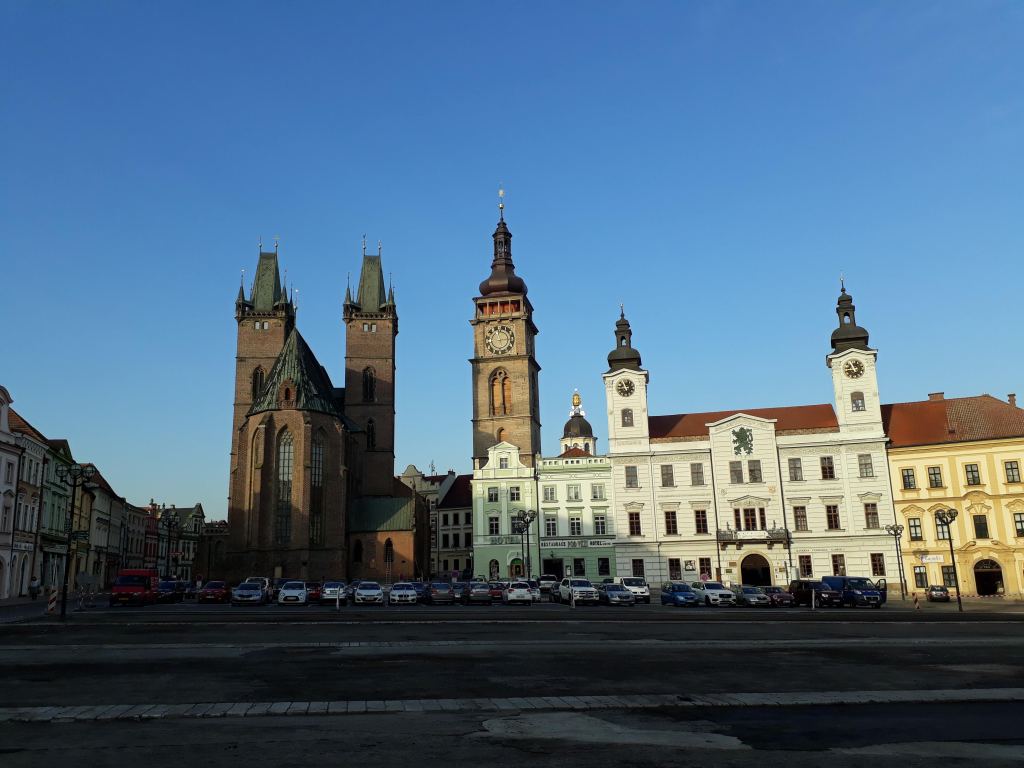
It takes only just over an hour to travel on a scheduled direct train from Hradec Králové to Prague, but by taking a rather circuitous route the Chess Train would stretch this journey time to over four hours. There was just one final game to be played on this day. I was playing the Swedish man I had beaten in the second round of the 2017 tournament. The game was less wild than our previous encounter, but my opponent slowly ground me down to inflict a defeat. On a sad note, this was the last game my opponent was ever to play on the Chess Train. I was surprised not to see him on the starting list for the 2019 tournament and I learnt, when I went on the 2019 Chess Train myself, that he had died in the intervening period.
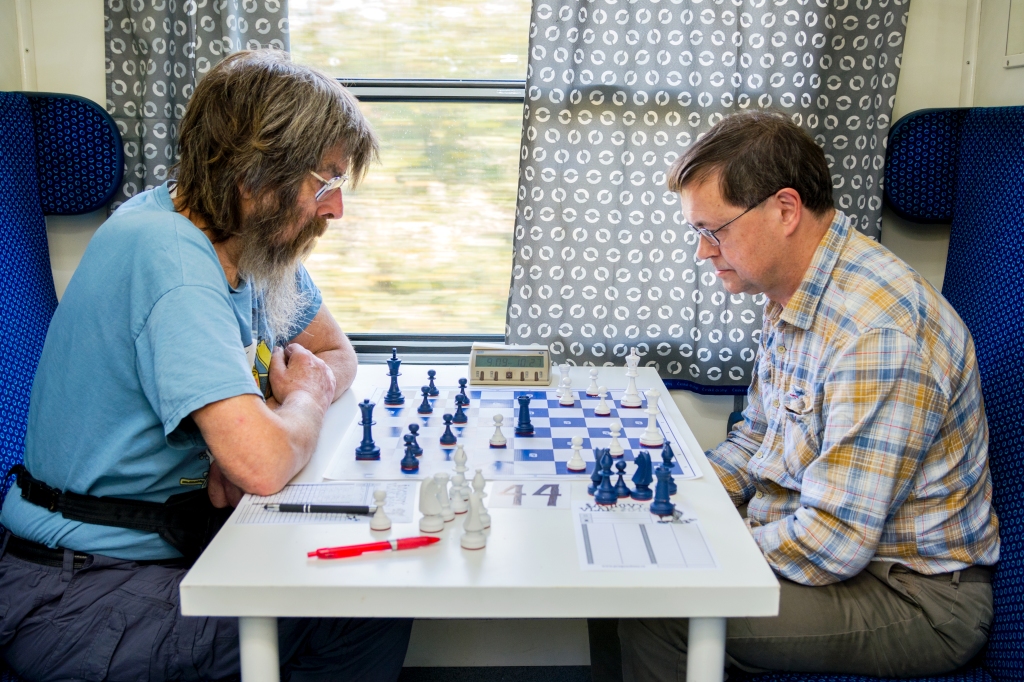
Shortly after the game had concluded we arrived in Choceň, which is further from Prague than Hradec Králové. There was a lengthy halt here which was used for various photo opportunities and media interviews – the Chess Train usually gets coverage on Czech TV each year. After leaving Choceň we again went through Pardubice and up the line towards Hradec Králové. Only when we were nearly back in Hradec Králové did the train turn off and head towards Prague.
We arrived at Praha hlavní nádraží shortly before 3pm and made our way again to the Government Lounge for the reception and prize-giving. The guest of honour who gave out the top prizes was the legendary ex-Czech Grandmaster Vlastimil Hort. The winner of the tournament was an Australian, Guy West, whose wife I had played in the fifth round. In total, I scored 3.5 points, the same as I managed the previous year, despite having two more rounds this year. Notwithstanding my sub-par playing performance, I had enjoyed the experience in 2018 just as much as on my first trip. Normally arrangements for the following year are revealed at the closing ceremony, but on this occasion nothing could be confirmed. (Fortunately, it was possible to run the Chess Train again in 2019, which I hope to write about on a future occasion.) Having thanked all the organisers, I reluctantly departed and walked back to my hotel.
For dinner, I went back to the establishment I had visited for the first time at the start of this trip. This time there were no incidents involving dogs. I ordered Pork Schnitzel to eat, but given a choice of sizes, I chose the larger one. This may have been a mistake, as it was considerably bigger than I was expecting and it took me some time to finish it.
Wednesday 17 October – Prague to London
As my flight back to London was not until the afternoon, I had a final morning to spend in Prague. When I had visited the National Technical Museum a week earlier, I had noticed nearby the National Museum of Agriculture. Having researched it subsequently, I discovered that to celebrate its centenary the museum was offering free entry that month. I decided to pay it a visit. When I arrived, I went up to the ticket desk and the conversation went as follows:
– Me: “I would like to visit your museum.”
– Museum official: “You do know that this is the agriculture museum?”
– Me: “Yes”
– Museum official: “And you still want come in?”
– Me: “Yes”
– Museum official: “In that case admission is free today.”
– Me: “I know.”
The National Museum of Agriculture was even more interesting than I expected. As well as the permanent displays, to mark its centenary there was a special exhibition on The Phenomenon of Agriculture in 100 Objects, describing agricultural advances (and some setbacks) from the dawn of time to the present day. I found the quirky selection of objects and the description of their significance particularly interesting. On the roof of the museum was a roof garden with good views over central Prague.
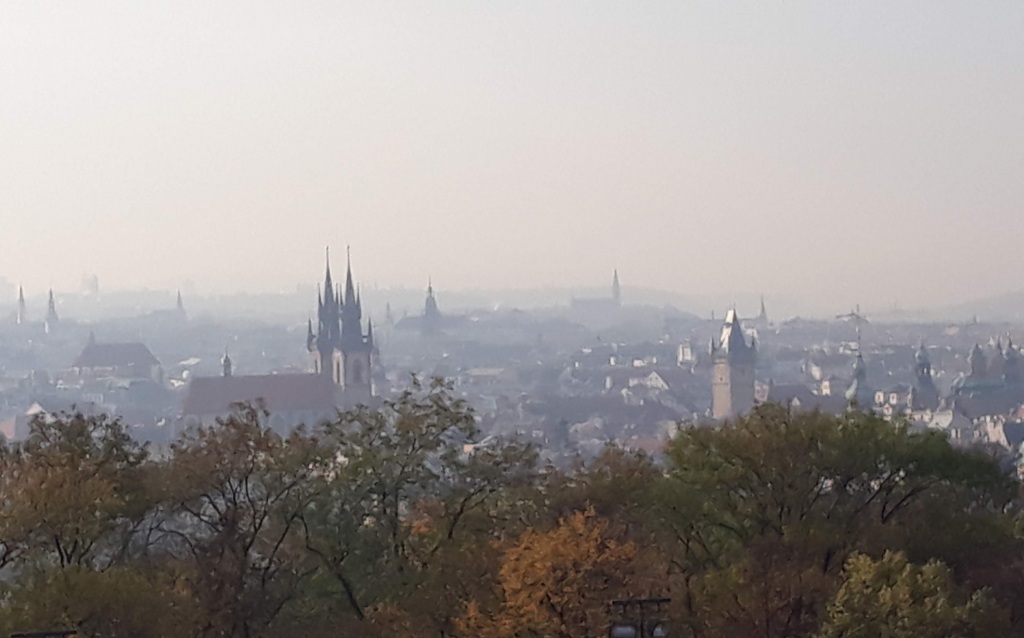
After leaving the Agriculture Museum, I just had time to go back to the centre of the city to visit The Celts, a special exhibition that was on at the annex of the National Museum. I had always associated the Celts with the western fringes of Europe, not realising that that they had also settled in Iron Age Bohemia.
Once I had finished looking at the Celts, all that remained for me to do was make my way to the airport at the end of another very enjoyable week.
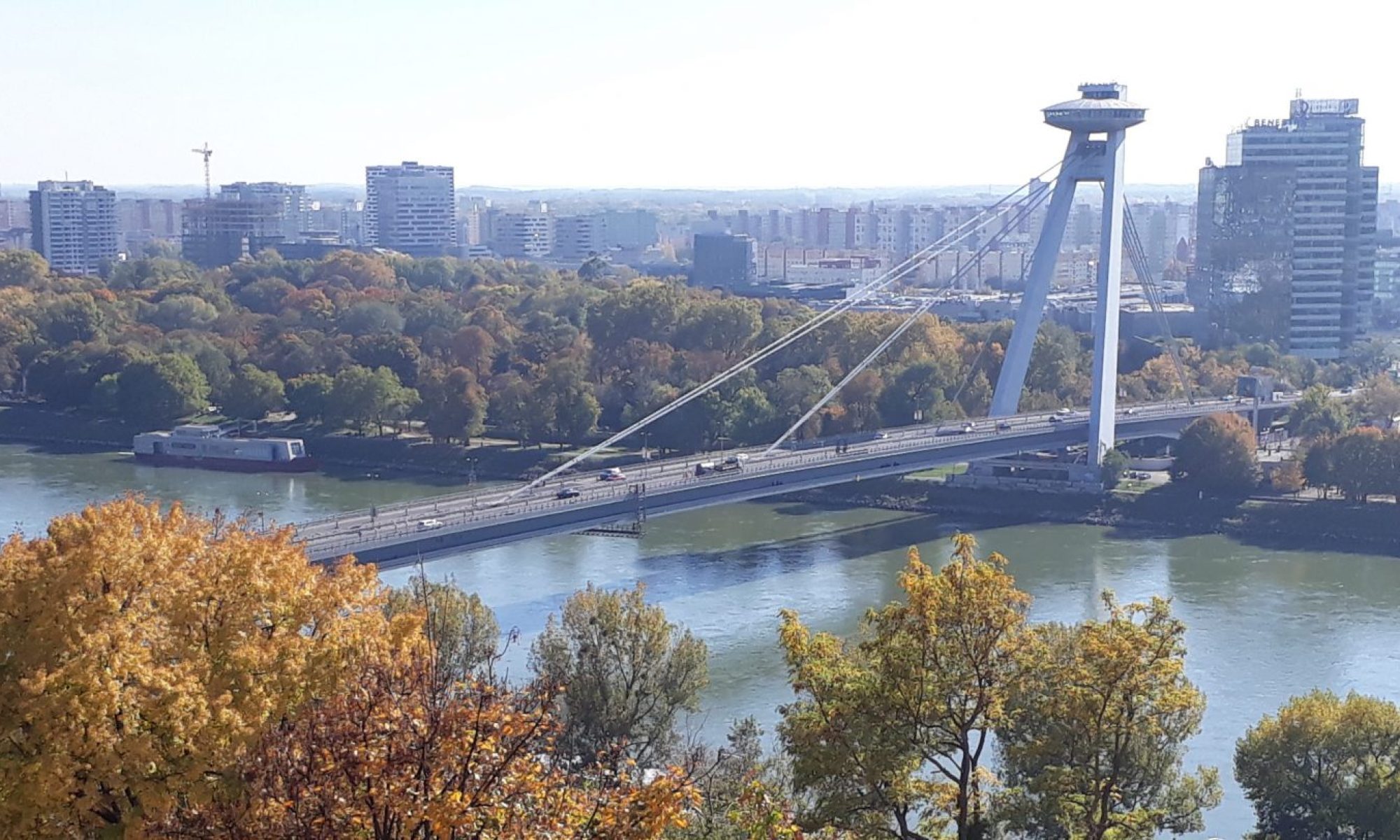
2 Replies to “Chess Train 2018”